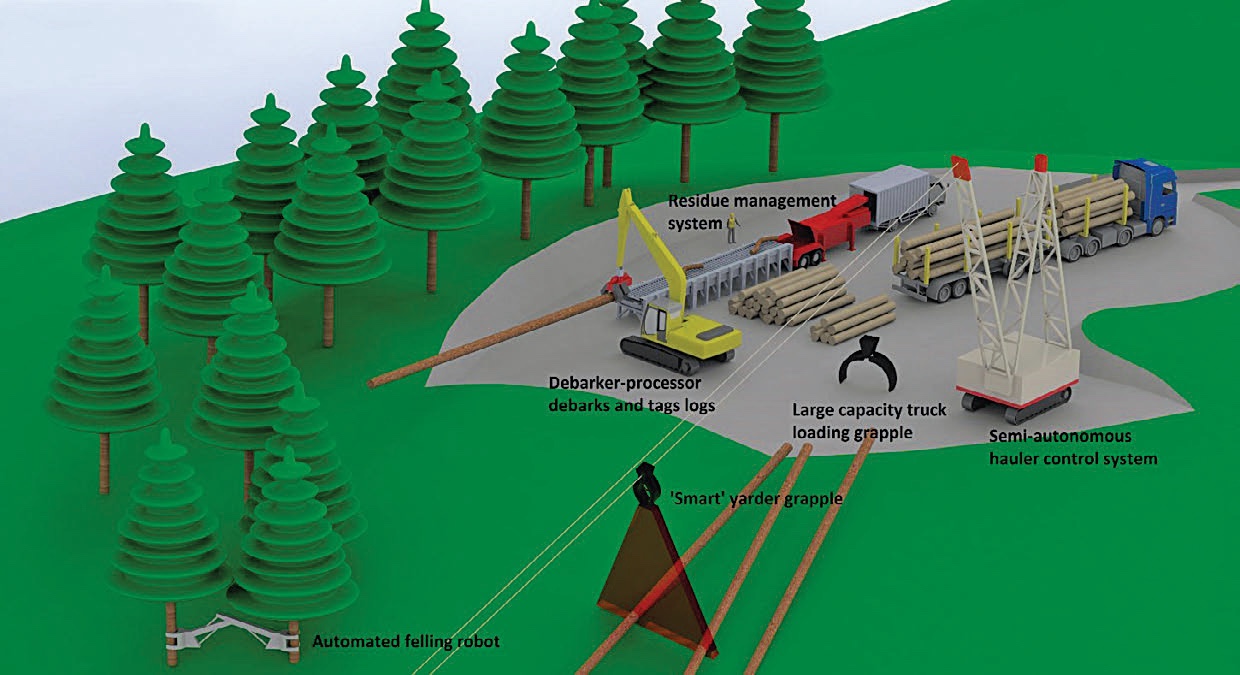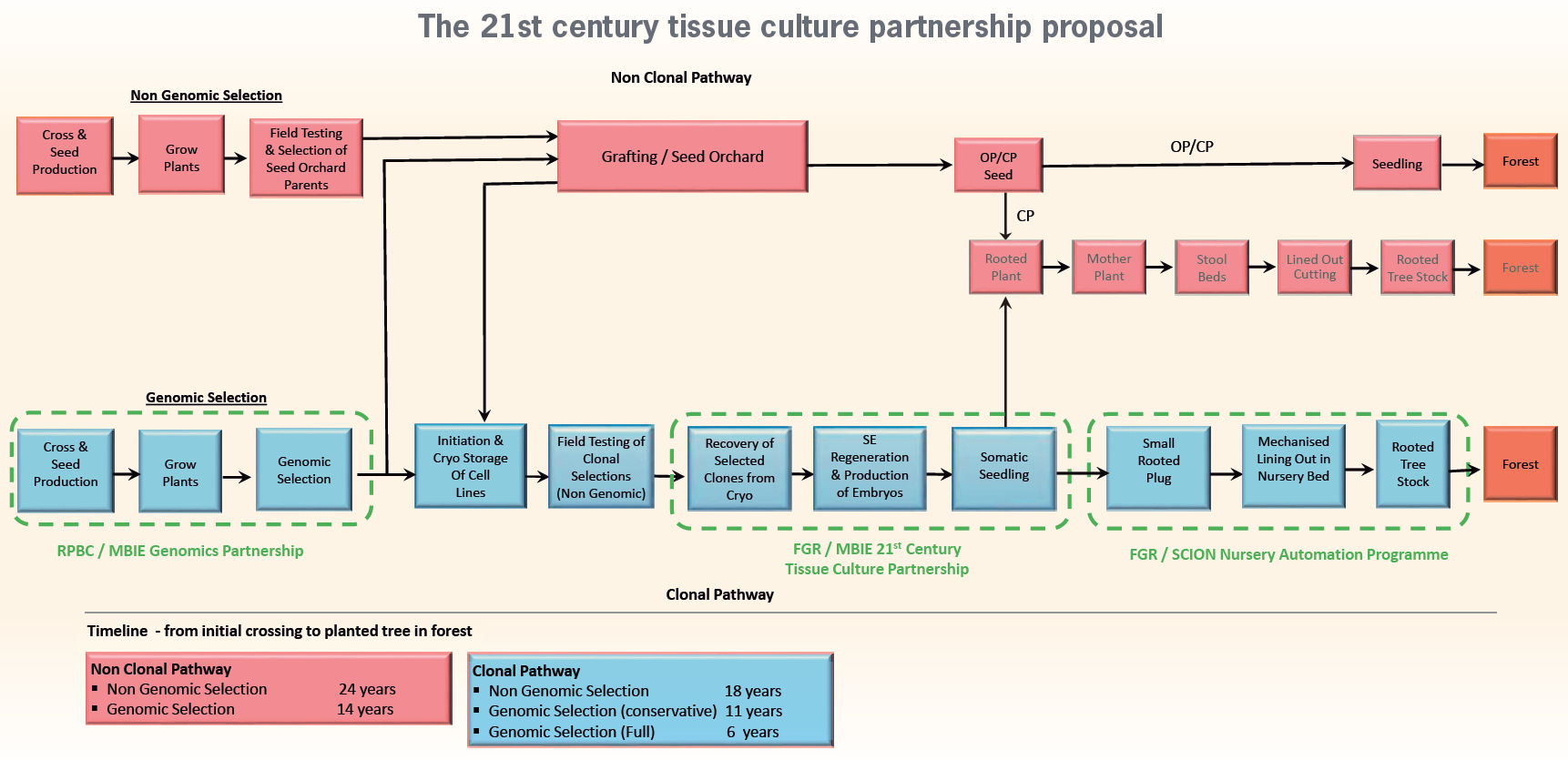
This is free.
A new phase of science innovation
Russell Dale and Harriet Palmer, New Zealand Tree Grower May 2019.
Contributing to a low-carbon future for New Zealand, boosting forest productivity and health, reducing environmental impacts and improving worker skills and safety, are all behind a new science innovation strategy being developed by the Forest Growers Research Committee. The new strategy has evolved from of a series of workshops held in 2018 when representatives of the forest industry and research sectors put their heads together to create a framework of future research priorities out to 2035. In this article we present a summary of new research projects either under way or where funding bids have been submitted.
Forestry work in the modern age
A new seven-year project Te Mahi Ngahere I te Ao HuriHuri – Forestry Work in the Modern Age is already under way, and was officially launched at Parliament in mid-March. The project, with a total budget of $29.36 million follows on from the successful Steepland Harvesting project. That project resulted in a whole suite of new harvesting technology reaching commercialisation stage, and will produce direct financial benefit for many forest owners.
The basic premise of the new project is that harvesting systems can be transformed with the use of automation and robotics. The concept includes bringing logs out of neighbouring forests to shared, central sorting, stacking and loading facilities, which will be high-tech, safe and efficient places to work.
The systems envisaged are particularly applicable in steep, erodible land and smaller forests. The forests have high harvesting costs which, when coupled with the cost of earthworks and building skid sites large enough to cope with conventional log sorting and loading, can make harvesting marginal when it comes to the economics of the process.
Advantages of the new systems will include −
- A significant reduction in earthworks, including skid-site construction within forests, reducing environmental risks in what are already fragile environments
- An increase in worker safety and skills. Traditional jobs on the ground on forest skids are relatively dangerous and low-skill, whereas the new log-sorting facilities will see workers trained to use high-tech equipment in safe environments
- An increase in efficiency and productivity of the whole system of getting logs to market.
These innovative systems are predicted to produce operational cost savings across the industry of $27 million a year by 2025 and $76 million a year by 2030. Owners of small forests will be among the major beneficiaries. Funding is via a Ministry for Primary Industries Investment Partnership, with major contributions from MPI and a consortium of forest owners. The project manager is Keith Raymond of Forest Growers Research. There was an early description of this project in the November 2017 Tree Grower.

Building resilient forests
Two major Scion-led research programmes – Growing Confidence in Forestry’s Future and Healthy Trees, Healthy Future – wind up in 2019. The first of these projects, Scion’s flagship radiata pine research programme from 2013 to 2019, has seen some big advances including a raft of new remote sensing and other aerial technology, and a network of accelerator trials to test new genetics and nursery techniques. The Healthy Trees, Healthy Future programme has also made major gains, and results will improve cost-effective management of phytophthora diseases including red needle cast and kauri dieback.
A new six-year, $42 million proposal brings together several research teams and researchers under one umbrella – that of using trees to help New Zealand transform to a low carbon economy. The proposal ‘Resilient Forests: Balancing long-run socio-economic benefits and risks in an uncertain future’ has been designed to take a fully integrated approach to social, environmental and economic aspects of forestry. Reducing the length of radiata pine’s economic rotation while maintaining wood quality, and the development of new products and markets, are amongst the research aims. One emphasis is on diversification to reduce risk. The good news for farm foresters is that while radiata pine is still the primary focus, alternative species are in the frame.
The proposal has been submitted to MBIE, with supporting co-funding committed by the Forest Growers Levy Trust amongst others. The project will be led by Dr Peter Clinton, and will involve national and international collaboration.
Innovative to speed up genetic gain
Scion’s tree breeders have also been an integral part of the Growing Confidence in Forestry’s Future and the Healthy Trees, Healthy Future projects, often working in conjunction with the Radiata Pine Breeding Company. The challenge for New Zealand tree breeders now is to find ways to reduce the time it takes to get the best material produced by the Radiata Pine Breeding Company into our forests. Currently it takes around 25 years − almost a full rotation − to graft, fully test, establish seed orchards, produce seed and then propagate via cuttings before tree stocks are ready to plant into the forest.
Researchers recently completed a whole of rotation assessment of improved genetic tree stocks planted in the early 1990s. This work has shown value gains of between 20 and 30 per cent for the best genetic material available to growers at the time these stands were planted.
With such significant gains being possible, getting this material into the forest quickly is important to maximise the return on the substantial investment being made in breeding and genomics. Genomic selection techniques offer the potential to speed up the selection process but the big gains and the introduction of clonal forestry depend on reliable and cost effective tissue culture.

Working closely with industry and Scion, Forest Growers Research has put together a proposal to develop an automated tissue culture process. The technique offers the potential to reduce the time to deploy tested clones from breeding and genomics programme to less than 10 years, possibly as short as six years. The value for the forest growing industry is significant perhaps hundreds of millions of dollars if this can be achieved.
With the funding support of the Forest Growers Levy Trust, and the full support of Radiata Pine Breeding Company and seed and clonal producers, a funding application has been submitted to the MBIE’s Partnership Fund 2019.
The need for a new research strategy
The forest industry contributes to research via the levy on harvested products and through direct partnerships with the research sector as well as with membership
of the various committees and steering groups which oversee research activities. Owners of small forests are an integral part of the set-up, with representatives on several of the relevant committees and steering groups.
Forest Growers Research, led by Russell Dale, manages most of New Zealand’s forest-growing research, and is closely aligned with the Forest Growers Levy Trust. The collaborative industry and research structure is well-established, and has proved successful in obtaining funding and in producing results which are relevant to industry needs.
Some major research programmes are coming to a close in 2019, so the development of a new long-term
science innovation strategy was a priority during 2018, and has led to this new suite of proposed research programmes.
Main research providers − Scion, Manaaka Whenua-Landcare Research, University of Canterbury, Lincoln University, and the Marlborough Research Centre.
Major research funders − Forest Growers Levy Trust, the Ministry for Business, Innovation and Employment, the Ministry for Primary Industries and members of the forest industry.
If you want to know more about forest research you can look on the website www.fgr.nz under research programmes.
Improving landslide and slash risk
The forest industry has already made a number of changes to reduce the risk of landslides and debris flows on steep, highly erodible land during storms. Much of this steep land is suited to tree-cover of some sort. However, foresters need more high-resolution methods to accurately describe the land-types they are dealing with. Also needed is better guidance on how best to mitigate the risks associated with production forestry on steep, erodible land.
A proposed four-year, $8.8 million research programme, led by Manaaka Whenua-Landcare Research, aims to map and classify erosion-prone land at much higher resolution than exists at present. The research will also improve understanding of what triggers landslides and debris flows, and how catchments interact. The results will include new ways of helping risk assessment on erosion-prone land, and guide management decisions and risk mitigation around harvesting, re-planting and new planting on high-risk land types. Funding for this project would be via an MBIE Endeavour Fund.
Extending the urban battlefield
The Urban Battlefield project, which took a multi-faceted approach to improving biosecurity near potential pest entry points such as airports and ports, had some impressive results. The most notable of these was a world-first ‘cyborg’ − a drone fitted with sensors capable of detecting specific insect pests by picking up pheromone signals. The innovation won last year’s prestigious Forest Growers Research award for Science of International Quality.
The proposed follow-on project – Pikoura of Protection: Integrated plant biosecurity for primary sectors and conservation lands will take work on bio-sensors to new levels. The aspiration is to develop sensors which can detect plant diseases in their early stages of infection, and before they can be seen. The research will enable the technology and expertise generated during the Urban Battlefield project to increase as part of continuing efforts to improve biosecurity responses in urban areas.
This five-year, $20 million project will be a combined Scion and Plant and Food Research effort. The application has gone into the MBIE Endeavour Fund.
Rethinking safety
Despite the significant amount of effort which has gone into keeping forestry workers safe, accidents in the forest are still happening. Researchers have acknowledged that a different approach to worker safety is needed, and a novel project aims to identify the differences in brain function between workers who are safe, and those who are not. The research will build on the theory that experienced forest workers develop a sixth sense, or intuition, which helps keep them safe.
By creating virtual reality forest environments and then putting experienced foresters to work in them, researchers hope they will be able to learn more about how experienced workers’ brains respond to different real-life scenarios. Sophisticated brain-scanning technology will be used. The expectation is that different cue patterns, which are processed automatically during skilled decision making, can be identified.
If what is learnt about expert intuition can ultimately be transferred to less experienced workers, the hope is that these people can learn to work in a safer way. This five-year, $15.5 million project will led by Scion’s behavioural scientists Brionny Hooper and Richard Parker, and will involve top medical researchers from New Zealand and overseas, and virtual reality experts.
Russell Dale is Research Manager, Forest Growers Research. Harriet Palmer is an independent forestry communications specialist.

 Farm Forestry New Zealand
Farm Forestry New Zealand